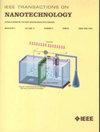Full 3-D Monte Carlo Simulation of Coupled Electron-Phonon Transport: Self-Heating in a Nanoscale FinFET
IF 2.1
4区 工程技术
Q3 ENGINEERING, ELECTRICAL & ELECTRONIC
引用次数: 0
Abstract
To study coupled electro-thermal transport processes in nanoscale electronic devices, continuum models are no longer sufficient. In this work, we present an effort to couple a three-dimensional (3-D) Monte Carlo Phonon Transport (MCPT) kernel with a 3-D Monte Carlo Electron Transport (MCET) simulator. The phonon-phonon scattering is modeled in relaxation time approximation (RTA) using Holland's formalism. Diffusive boundary collisions for phonons is modeled using the Beckmann-Kirchhoff (B-K) surface roughness scattering formalism considering the effects of phonon wavelength, incident angles and degree of surface roughness. In the electron-phonon coupled platform, acoustic and intervalley电子-鹭鸶耦合传输的全三维蒙特卡罗模拟:纳米级 FinFET 中的自加热
要研究纳米级电子器件中的电热耦合传输过程,连续模型已不再足够。在这项工作中,我们努力将三维(3-D)蒙特卡洛声子传输(MCPT)核与三维蒙特卡洛电子传输(MCET)模拟器结合起来。声子-声子散射采用霍兰形式主义的弛豫时间近似(RTA)建模。声子的扩散边界碰撞采用贝克曼-基尔霍夫(B-K)表面粗糙度散射形式主义建模,考虑了声子波长、入射角和表面粗糙度的影响。在电子-声子耦合平台中,考虑了声学和间隙 g 和 f 型电子-声子散射机制,并利用由此产生的局部温度修正来连接电子和声子传输路径。通过对纳米级 FinFET 器件中的自热效应建模,该模拟器得到了验证。在这里,氧化物-硅界面上的声子传输采用扩散错配(DM)模型进行处理,而氧化物中的声子则采用德拜模型以及与温度和频率相关的弛豫时间进行描述。对于栅极长度为 18 nm、沟道宽度为 4 nm、鳍片高度为 8 nm 的 FinFET,模拟结果显示,由于自发热,导通电流衰减高达 ∼ 7%。沟道区域的温升为 30 K。
本文章由计算机程序翻译,如有差异,请以英文原文为准。
求助全文
约1分钟内获得全文
求助全文
来源期刊

IEEE Transactions on Nanotechnology
工程技术-材料科学:综合
CiteScore
4.80
自引率
8.30%
发文量
74
审稿时长
8.3 months
期刊介绍:
The IEEE Transactions on Nanotechnology is devoted to the publication of manuscripts of archival value in the general area of nanotechnology, which is rapidly emerging as one of the fastest growing and most promising new technological developments for the next generation and beyond.
 求助内容:
求助内容: 应助结果提醒方式:
应助结果提醒方式:


